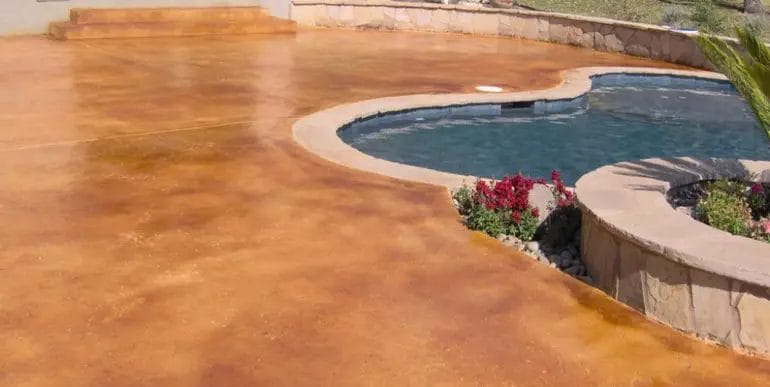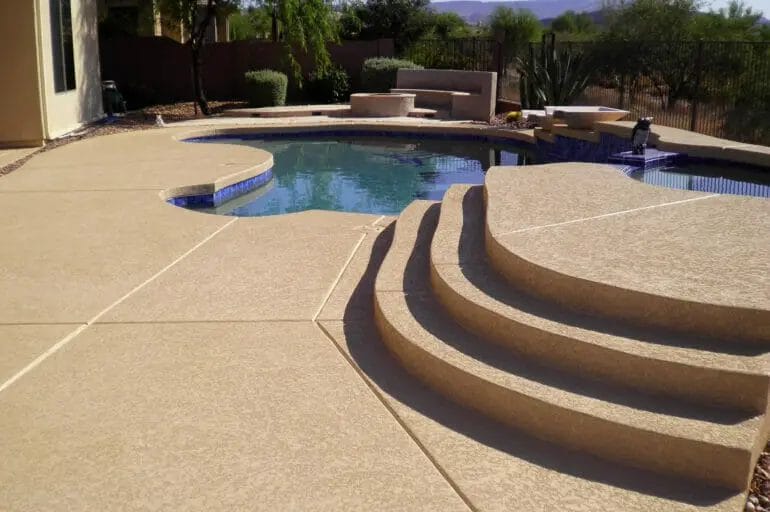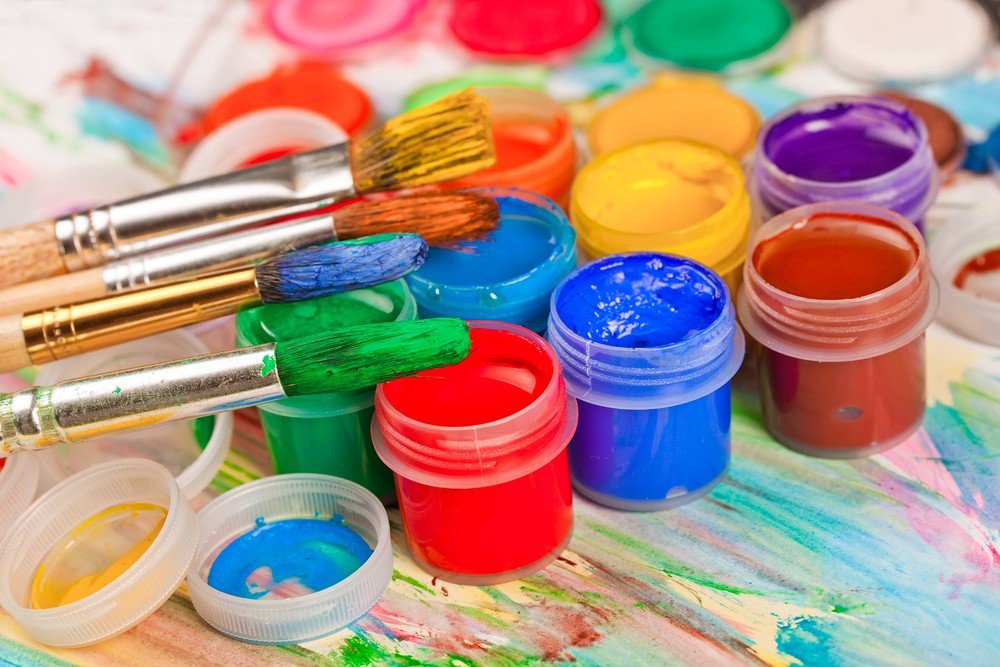Looking to refresh your pool’s appearance? Painting your pool with acrylic paint can be a cost-effective and creative option. Acrylic paint offers excellent durability, UV resistance, and a wide range of color choices. With proper preparation and application, you can transform your pool into a stunning oasis. In this guide, we will walk you through the step-by-step process of how to paint a pool with acrylic paint.

Prepping Your Pool for Acrylic Paint Application
When it comes to giving your pool a fresh and vibrant look, acrylic paint can be a great choice. Not only does it offer durability and resistance to fading, but it also provides a smooth and glossy finish. However, before you start applying acrylic paint to your pool, proper preparation is crucial to ensure a long-lasting and beautiful result. In this section, we will guide you through the essential steps to prep your pool for acrylic paint application.
1. Clean the Pool
The first step in prepping your pool for acrylic paint application is to thoroughly clean the surface. Remove any debris, leaves, or dirt from the pool using a pool skimmer or net. Scrub the walls and floor of the pool using a pool brush and a pool cleaner or mild detergent. Rinse the pool thoroughly to remove any cleaning residue.
2. Repair Any Damages
Inspect the pool for any cracks, chips, or other damages. These should be repaired before applying acrylic paint to ensure a smooth and even surface. Use a pool repair kit or epoxy-based patching compound to fix any imperfections. Follow the manufacturer’s instructions for proper application and drying time.
3. Remove Existing Paint
If your pool already has existing paint, it is essential to remove it before applying acrylic paint. Use a paint stripper or sandblasting equipment to remove the old paint. Be sure to follow all safety precautions and wear protective gear during this process. Once the old paint is removed, clean the surface again to remove any residue.
4. Prepare the Surface
Before applying acrylic paint, the surface of the pool needs to be properly prepared. Start by using a pool acid wash to remove any mineral deposits or stains. This will help the paint adhere better to the surface. Rinse the pool thoroughly after the acid wash to neutralize the pH level.
Next, use a pool primer specifically designed for acrylic paint. Priming the surface will provide a smooth and stable base for the paint. Apply the primer according to the manufacturer’s instructions and allow it to dry completely before proceeding to the next step.
5. Apply Acrylic Paint
Once the surface is properly cleaned, repaired, and primed, you can begin applying the acrylic paint. Choose a high-quality acrylic paint that is specifically formulated for use on pools. Apply the paint using a paint roller or sprayer, working in small sections at a time. Follow the manufacturer’s instructions regarding the application process, including the number of coats required and the drying time between coats.
6. Allow Sufficient Drying Time
After applying the acrylic paint, it is crucial to allow sufficient drying time before filling the pool with water. Follow the manufacturer’s instructions for the recommended drying time. During this period, ensure that the pool remains protected from dust, debris, and any potential damage.
7. Fill the Pool
Once the acrylic paint is fully dried, you can proceed to fill the pool with water. Take care not to damage the newly painted surface during this process. Monitor the water quality and balance the chemicals as needed to maintain a healthy and clean pool.
8. Regular Maintenance
While acrylic paint offers durability and longevity, regular maintenance is necessary to keep your pool looking its best. Follow a proper pool maintenance routine, including regular cleaning, water testing, and chemical balancing. Avoid using abrasive cleaning tools or harsh chemicals that can damage the paint. With proper care and maintenance, your acrylic-painted pool will continue to impress for years to come.
In summary, prepping your pool for acrylic paint application involves cleaning the pool, repairing any damages, removing existing paint, preparing the surface, applying acrylic paint, allowing sufficient drying time, filling the pool, and regular maintenance. By following these steps and using high-quality products, you can achieve a stunning and long-lasting result that will enhance the beauty of your pool.

Step-by-Step Guide to Painting Your Pool with Acrylic Paint
If you want to refresh the look of your pool and protect its surface, painting it with acrylic paint is a great option. Acrylic paint is known for its durability and ability to withstand various weather conditions. In this guide, we will walk you through the step-by-step process of painting your pool with acrylic paint, ensuring a professional and long-lasting finish.
Materials You Will Need:
- Acrylic pool paint
- Pool primer
- Paint roller
- Paint tray
- Painters tape
- Sandpaper
- Power washer
- Pool brush
- Protective gear (goggles, gloves, mask)
Step 1: Prepare the Pool
The first step in painting your pool is to thoroughly clean the surface. Begin by draining the pool and removing any debris or loose paint. Use a power washer to remove dirt, algae, and other contaminants. Once the surface is clean, allow it to dry completely before moving on to the next step.
Step 2: Repair Any Damaged Areas
Inspect the pool surface for any cracks or chips. If you notice any damaged areas, use a pool repair kit to fix them. Follow the manufacturer’s instructions for repairing and smoothing out the surface. Allow the repaired areas to dry before proceeding.
Step 3: Apply Primer
Before applying the acrylic paint, it is essential to prime the pool surface. Apply a coat of pool primer using a paint roller or brush. Ensure that the primer is evenly distributed and covers the entire pool surface. Let it dry according to the manufacturer’s instructions.
Step 4: Tape Off and Protect
To avoid getting paint on areas you don’t want to paint, use painters tape to tape off any borders, edges, or fixtures around the pool. Cover any surrounding surfaces, such as tiles or decking, with plastic or drop cloths to protect them from paint splatters.
Step 5: Start Painting
Now it’s time to apply the acrylic paint to your pool. Start by pouring the paint into a paint tray. Use a paint roller to evenly apply the paint onto the pool surface. Work in small sections, overlapping each stroke to ensure a smooth and uniform finish. If necessary, use a pool brush to reach tight corners or edges.
Step 6: Apply Multiple Coats
For optimal coverage and durability, it is recommended to apply multiple coats of acrylic paint. Allow each coat to dry completely before applying the next one. Follow the manufacturer’s instructions regarding the drying time between coats.
Step 7: Remove Tape and Clean Up
Once you have applied all the necessary coats of paint and they have dried, carefully remove the painters tape. This will reveal clean, crisp edges. Dispose of any remaining paint properly and clean your painting tools according to the paint manufacturer’s instructions.
Step 8: Fill the Pool
After the paint has fully cured, you can proceed to fill your pool with water. Follow the guidelines provided by the pool paint manufacturer regarding the recommended waiting time before refilling the pool.
Step 9: Maintain and Enjoy
Congratulations! You have successfully painted your pool with acrylic paint. To ensure the longevity of the paint job, regularly clean and maintain your pool. Use pool-safe cleaning products and avoid using abrasive tools or chemical cleaners that may damage the paint. Now, sit back, relax, and enjoy your revitalized pool!

Tips and Tricks for Achieving a Smooth and Long-Lasting Pool Finish
Having a beautiful and well-maintained pool can greatly enhance the aesthetics of your outdoor space. One key aspect of achieving a visually appealing pool is to ensure a smooth and long-lasting pool finish. A smooth finish not only looks great but also provides a comfortable swimming experience for you and your guests. In this section, we will discuss some tips and tricks to help you achieve a smooth and long-lasting pool finish.
1. Choose the Right Pool Finish
The first step in achieving a smooth and long-lasting pool finish is to select the right type of pool finish. There are several options available, including plaster, pebble, tile, and aggregate finishes. Each has its own unique characteristics and advantages. Plaster is a popular choice due to its affordability and smooth texture. Pebble finishes offer a more natural and textured appearance. Tile finishes are highly durable and can be customized to create stunning designs. Aggregate finishes combine small stones and pebbles to create a durable and attractive finish. Consider your preferences, budget, and maintenance requirements when choosing the right pool finish.
2. Prepare the Surface Properly
Before applying the pool finish, it is crucial to prepare the surface properly. This involves removing any dirt, debris, or loose material from the pool shell. Use a pressure washer or scrub brush to thoroughly clean the surface. Repair any cracks or chips in the pool shell to ensure a smooth and even finish. It is also important to check the pH and alkalinity levels of the pool water and make any necessary adjustments. Proper surface preparation will ensure that the pool finish adheres well and lasts longer.
3. Hire an Experienced Pool Finisher
While DIY pool finishing may seem tempting, it is recommended to hire an experienced pool finisher for the best results. A professional pool finisher has the knowledge and skills to properly apply the pool finish, ensuring a smooth and flawless result. They also have access to specialized equipment and materials that may not be readily available to a DIY enthusiast. Additionally, hiring a professional can save you time and effort, allowing you to relax and enjoy your pool sooner.
4. Follow Proper Application Techniques
When applying the pool finish, it is important to follow the manufacturer’s instructions and recommended application techniques. This includes mixing the finish material correctly, applying it in thin and even coats, and allowing sufficient curing time between layers. Avoid applying the finish in direct sunlight or extreme weather conditions, as this can affect its adhesion and overall quality. Following proper application techniques will help achieve a smooth and long-lasting pool finish.
5. Regular Maintenance and Care
Maintaining your pool regularly is essential to ensure a smooth and long-lasting finish. Regularly test and balance the water chemistry to prevent corrosive or scaling conditions that can damage the finish. Clean the pool walls and floor regularly using a pool brush and vacuum to remove any dirt or debris. Avoid using harsh chemicals or abrasive cleaning tools that can scratch or damage the finish. By regularly maintaining and caring for your pool, you can extend the life and beauty of the pool finish.
In summary, achieving a smooth and long-lasting pool finish requires careful consideration during the selection process, proper surface preparation, and following correct application techniques. Hiring a professional pool finisher and implementing regular maintenance and care practices are also crucial for maintaining the finish’s beauty and durability. By following these tips and tricks, you can enjoy a stunning and resilient pool finish for years to come.
Maintaining and Caring for Your Acrylic Painted Pool
If you have an acrylic painted pool, it is essential to properly maintain and care for it to ensure its longevity and keep it looking its best. Acrylic paint is known for its durability and resistance to chemicals, making it an excellent choice for pool surfaces. However, regular maintenance is still necessary to prevent wear and tear and to keep your pool in optimal condition. In this section, we will discuss the steps you need to take to maintain and care for your acrylic painted pool.
1. Regular Cleaning
Regular cleaning is the first step in maintaining your acrylic painted pool. It is essential to remove any debris, dirt, or leaves that may accumulate on the pool’s surface. You can use a pool skimmer or a pool vacuum to clean the pool regularly. Make sure to clean the walls, floor, and waterline to prevent any buildup of grime or algae.
2. pH Balance
Proper pH balance is crucial for the health of your pool and the longevity of the acrylic paint. The ideal pH range for an acrylic painted pool is between 7.2 and 7.8. You can use a pH testing kit to check the pH levels regularly and adjust them if needed. If the pH levels are too high or too low, it can cause damage to the paint and affect the water chemistry.
3. Chemical Treatments
In addition to maintaining the pH balance, you will also need to perform regular chemical treatments to keep the water clean and clear. Chlorine is commonly used to disinfect the water and prevent the growth of algae. However, it is essential to follow the manufacturer’s instructions and not use excessive amounts of chemicals, as it can damage the acrylic paint.
4. Surface Protection
To protect the acrylic paint and extend its lifespan, it is recommended to use a pool cover when the pool is not in use. A pool cover helps to prevent debris and sunlight exposure, which can cause fading and deterioration of the paint. Additionally, avoid using abrasive cleaners or scrub brushes that can scratch the surface.
5. Regular Inspections
Regular inspections are necessary to identify any potential issues or damage to the acrylic paint. Look for signs of chipping, cracking, or discoloration. If you notice any damage, it is important to address it promptly to prevent further deterioration. You may need to consult a professional to repair any significant damage.
6. Repainting
Over time, the acrylic paint may start to fade or lose its vibrancy. If this happens, you may need to consider repainting your pool. Repainting should be done by a professional to ensure proper application and adherence to the surface. It is recommended to repaint your pool every 5 to 7 years, depending on the wear and tear.
7. UV Protection
Exposure to sunlight can cause the acrylic paint to fade and deteriorate over time. To protect the paint from UV rays, consider using a UV-resistant clear coat or a paint with built-in UV protection. This will help to extend the life of the acrylic paint and maintain its color and vibrancy.
8. Professional Maintenance
While regular maintenance is crucial, it is also beneficial to hire a professional pool maintenance service to perform regular inspections and maintenance tasks. They have the expertise and knowledge to ensure that your acrylic painted pool is properly cared for and any issues are addressed promptly.
In summary, maintaining and caring for your acrylic painted pool involves regular cleaning, maintaining the pH balance, performing chemical treatments, protecting the surface, conducting regular inspections, considering repainting when needed, providing UV protection, and seeking professional maintenance. By following these steps, you can keep your acrylic painted pool in excellent condition for years to come.
FAQs
Q: How to paint a pool with acrylic paint?
To paint a pool with acrylic paint, follow these steps: 1. Drain the pool and clean it thoroughly. 2. Apply a primer specifically designed for pools. 3. Apply a specially formulated acrylic pool paint in even coats. 4. Wait for each coat to dry before applying the next. 5. Fill the pool with water after the final coat has dried.
Q: What are the benefits of using acrylic paint for pool painting?
Acrylic paint is a popular choice for pool painting due to its durability, resistance to chemicals and UV rays, and ease of application. It also provides a smooth and attractive finish, while allowing for easy maintenance and touch-ups.
Q: How long does acrylic pool paint typically last?
The lifespan of acrylic pool paint can vary depending on factors such as pool usage, maintenance, and climate. Generally, it can last anywhere between 3 to 7 years before requiring a repaint. Regular cleaning and proper pool maintenance can help prolong the lifespan of the paint.
Conclusion:
In conclusion, painting a pool with acrylic paint can be a cost-effective and aesthetically pleasing solution to revitalize your pool’s appearance. With its durability and resistance to water and chemicals, acrylic paint offers a long-lasting and vibrant finish. Additionally, the versatility of acrylic paint allows for various design possibilities, giving you the freedom to customize your pool according to your preferences.
However, before starting the painting process, it is crucial to properly prepare the pool surface and ensure it is clean and free from any debris. Applying a primer specifically designed for pools will provide better adhesion and enhance the durability of the paint. It is recommended to consult with professionals or follow manufacturer guidelines to ensure a successful pool painting project.
By following the correct procedures and using high-quality acrylic paint, you can achieve a beautifully transformed pool that will bring joy and relaxation for years to come.
